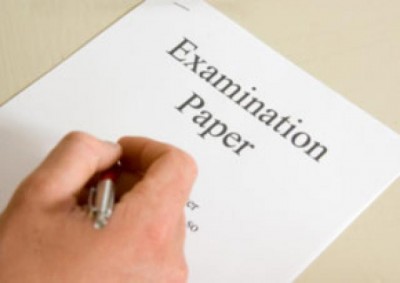State Board Commerce (XI-XII) - Test Papers
JEE MAIN & ADVANCE 12th PCM Physics -Electromagnetic Induction Module-2 Demo Videos
Hello, students, now let’s analyse the case of Motional EMF when B is not uniform along the length of the wire. See find the induced EMF in the rod. Current in the wire is constant and the rod is moving with constant velocity v in the vertical direction.
Now see due to the current carrying wire there will be a magnetic field but at a distance X we know magnetic field is Mu0i by 2 pi x . So basically magnetic field is varying along the length of the wire. It is constant with respect to time but along the length of the wire it is changing. Now we know induced EMF or motional EMF is integral v cross B.dl. Now B at different parts of rod is different. So what we have to do we have to find the small induced EMF at small element of the rod. So what we can do, we know v, B and dl are mutually perpendicular, so we can use Bv into dl. Net induced EMF will be the integral of v B into dl. Now see velocity of all the parts of the rod is v, what about the magnitude of B, B is equal to Mu0i by 2pi x. So in the element at a distance x whose length is dx, B at a distance x from the wire will be Mu0i by 2 pi x. So integral v instead of B for that element B will be Mu0i by 2 pi x. And what is the length of that element, the length is dx. So e is equal to integral v B and dx. Now what will be the limits of this integration? See we have to find the net induced EMF in the entire rod, so x will begin from a, it will come at the first end of the rod, so initial limit will be a. Now x has to be a plus L to cover the entire length. So initial was a to the limit a plus L. So this will be our limit, from a to a plus L. Now integration of 1 by dx is lnx constant and we can take it out. So vMu0i by 2 pi lnx, a to a plus L. Now lna minus lnb is lna by v so lna plus L minus lna will be lna plus L by a. So induced EMF will be Mu0iv by 2 pi lna plus L by a.
So when v is not constant over the length what we have to do, we have to take an element, find the small induced EMF in that part, integrate from the initial to final to get the total motional EMF in the rod.
Now suppose we have to find the direction, so direction we can use the same method, v cross b. So if we do v cross b we see left side will be the positive, right side will be the negative. Now suppose it is semi circular, now what we will do, integration will be a bit difficult, so we can use the concept of L effective c. v is constant for all the parts. Now B at different points is different but it is constant with respect to time, see suppose we have taken two points, B is constant now as the wire moves up, the distance of the point remains same. That means B at a point remains same. B at different points will be different, but as the wire moves B at one point will remain same. So B remains same so basically B is constant over the length. And v and B is perpendicular. So we can use the concept of L effective. So v cross B into L effective, L effective will be the same as the previous one. So the answer to this question will again be Mu0iv by 2 pi ln a plus L by a. So we have taken this as L effective. But we can only do this if v is constant, B at different points can be different, but B at one point should remain constant and v and B are perpendicular.
Suppose the situation was like this, this wire is moving towards right. Now if you take a point basically B will change, see if you take L effective and you write the answer as E is equal to 0, because L effective and v is along the length, but this will be incorrect. Why? See, because at same point when the wire moves B changes, suppose we take a point, initial the distance was x then when the wire moves like this the distance changes, so B at the same point changes so we cannot use directly the formula of L effective. So in these situations we have to solve it using integration which will be very complex. But we have to remember but we cannot use L effective in these cases. We have to check that v should be constant, B should be constant and they should be perpendicular.
Thank you.
Increase your scores by Studying with the BEST TEACHERS – Anytime and anywhere you want
State Board English-std VIII,Sanskrit,Demo Video Of Grammar Basic
Increase your scores by Studying with the BEST TEACHERS – Anytime and anywhere you want
Get Set for Your MBA Entrance Exams!
The MBA entrance exam season is on the brink of getting started. A number of candidates will be fine-tuning their preparation right now, whilst there will be others who would be struggling to kick the inertia out of their systems and start their preparation. Those who fall in the latter group, should not let the lazy voice within tell you: “Be practical, it’s too late”. Run away from those who spread negativity. You may come across people who may say, “I’m preparing for the last one year and it’s not working for me” or “These exams are really difficult to crack, it’s not our cup of tea”. Remember these are the people who don’t plan realistically or have laid back attitudes.
The basic syllabus for these exams is roughly the same as Mathematics and English taught in the class VII-X. So, ideally , if your fundamentals are in place then it should take roughly 250 hours of preparation which means just 5 hours for 50 days or 3 hours for some 85 odd days i.e. max 3 months. However, you need to be very focused in these 3 months and practice religiously. Also, you need not run after solving more and more questions, instead focus on solving different varieties of questions and remember the method used to solve these questions. There is a need to master the art of solving questions using shortcut techniques.
Having said that, a valid and essential question is: How to plan these exams? To begin with, preparation time should be divided into 2 phases.
Phase 1: Concentrate on building your basics and improve your accuracy
During this Phase, cover the basic concepts in quantitative aptitude for all the topics. This is the phase where you build on the basic principles and prepare yourself for the tougher questions. Remembering reciprocals till 30, squares till 30, cubes till 15, and multiplication tables till 20 is a must to increase speed.
For e.g. If the question is: After giving a discount of 9.09% a shopkeeper still manages to gain a profit of 11.11% then find the mark-up percentage?
If we know that 9.09% is and 11.11% is then this question can be solved in less than a minute time.
Solution:
If the cost price of an article is Rs. 9 then it makes a profit of Re. 1. Thus, selling price should be Rs. 10.
If the mark price of an article is Rs. 11 then the discount given is Re. 1. Thus, the selling price should be Rs. 10.
Now, the cost price is Rs. 9, mark price is Rs. 11 then the marked-up price is Rs. 2 over the cost price of Rs. 9. Thus, mark-up percentage is 22.22%.
So, remembering reciprocals helps to save ample time in many questions in Quant as well as DI.
Also, making an equation and solving it makes the solution ugly and wastes precious time. So, the focus should be on learning the art of solving majority of the questions without using equations.
For the verbal section, set aside 1-2 hours every day to reading. Read different genre of articles varying from fiction to politics to science to anything. Just build reading habit and get the mind ready for any topic, style or subject. Vocabulary building will also play a rational role in this phase.
Phase 2: Concentrate on increasing number of attempts
In this phase start by practicing 2 Data Interpretation sets (once you are through with different varieties of questions from Percentage Module), 2 Logical Reasoning set, 5-10 Advanced Reasoning questions (word based puzzle, math based puzzle, Input-Output questions etc) , 1 RC and 20 math questions (from various topics) on an day to day basis. Try to improve your concentration by practicing for 3 hours at a stretch. This will help reduce concentration lapses during the Mock Test and eventually the actual test. It is time that you start practicing 1-2 Mock Tests on a weekly basis and try to figure out your strengths and weaknesses. Don’t take Mocks like mock test rather take it like your actual test mimicking the exam day scenario.
2 months before the exam, your motive should be to find out your strengths and weaknesses. The focus should be on SWOT analysis of your preparation in stage 1. Followed by it, work towards improving on weak areas by providing exhaustive practice. One should divide syllabus into four different areas:
|
A High Speed High Accuracy |
C
High Speed Low Accuracy |
| B
Low Speed High Accuracy |
D Low Speed Low Accuracy |
- Dedicate 2 days to practice questions in A and try to build 100% accuracy in the questions from these areas.
- Dedicate 3 days to practice questions in B and try to move them in A.
- Dedicate 1 day to practice questions in C and D to improve accuracy and try to move them in B.
In every mock that you take, try to increase your attempts slowly and gradually. Before every mock that you take, analyse the questions that you either attempted wrong or didn’t attempt in the previous mock. Without that, it won’t make any sense to take the next mock. Your analysis should include questions like:
(a) Where did I go wrong in these questions?
(b) Why did I not attempt these questions?
(c) Why am I making mistakes in these areas?
(d) Am I selecting the right questions?
(e) How many questions that I skipped were do-able?
Also, make sure that the mistakes once made should not be repeated.
More importantly do not take 2 Mock tests on the same day to increase your Mock count. It won’t help. Analysis after every test is very important in order to improvise your scores in the next test.
Tips to be followed:
1. Admit to yourself that “I will not know all of the answers.” No matter how hard you have studied.
2. If you feel nervous on a question, skip to the next question. Don’t waste time on a question that you don’t know.
3. Never panic about test. You will still be the same the person whatever marks you get, so it doesn’t matter how well you do.
You may be interested in the following:
MBA Entrance Exams
Tips to get through to a Good B School
More Personal Interviews
8 Tips To Crack Personal Interview for B-School Admission
How MBA Interviews differ from regular ones?
Do’s and Don’ts in a Personal Interview
Group Discussions
Tips and Strategy for Group Discussion
Tips to get through to a Good B School
Congratulations to those who have received a call from a B-school
In the second round, top B-school evaluates any candidate on basis of GD and/or WAT and PI.
The first thing that a candidate should focus on is building the content on areas such as politics, economics, any specialisation they want to pursue and the major events that took place over last two years. This will act as catalyst for Group Discussion (GD) and Written Ability Test (WAT).
WAT tests not only the quality of your content, but also the writing style. To build on these two, one must read newspapers and magazines, and cover a wide variety of topics ranging across the domestic and the international circuit.
It is important to get into the habit of building opinions rather than merely collecting facts.
Practice and evaluation is the only key to cracking WAT. The following points need to be kept in mind while writing WAT.
- Understand and analyze the topic
- Never take a rigid stand – Give analysis on both side of the topic and then at the end show your inclination toward one side
- Follow a proper structure
- Make it Short and Simple without any flowery language
A student when prepared for WAT is automatically prepared for GD. The only thing that one needs to keep in mind is the way you put across your point and the way you communicate.
Before starting to prepare for PI, one should write a biographic sketch. This will help students to analyze themselves and will help them to answer personal questions in a much better way. One should prepare for basic questions like “Introduce yourself”, “Why do you want to do MBA?”, “Why a particular specialisation?”, “Short-term and Long-term goal” and other personal questions. The confidence shown and the content covered while answering such questions will drive the course of the interview.
Shortlist the B-Schools before they shortlist you!
Study the placements records, ROI, alumni network and specialisation that the B-school provides.
For example, FMS is considered as best B-school when it comes to ROI. If one wants to specialise in HR then XLRI and TISS are considered to be India’s best B-school. Similarly, branding and communication goes with MICA. In today’s world where B-schools are charging sky-rocketing fees it essential to understand ROI. If the fees is Rs. 12,00,000 excluding boarding and lodging charges and average placement is Rs. 6,00,000 then ROI will be worst as compared to if the fees Rs. 6,00,000 and average placement is Rs. 4,50,000. Don’t run after better average salary. Look for better ROI and for better placements in terms of profile. Also the most important thing would be to do an MBA from the college where your interest lies and not from the college which gives you a good average salary.
What if your CAT score is not enough to get in your dream B-school?
Don’t be disheartened. It’s part and parcel of life. Many students wait for a year before get in their dream B-school. Usually, students do their MBA from whichever college they get in. Some of them never do their MBA. It’s always better to have an MBA degree on your resume instead of not having one. So, even if your CAT scores are not good this year wait for a year to get in a good B-school, provided you have time to wait for a year!! If not then there are many exams which are yet to come such as CMAT, CET, ATMA and MAT. Appear for these exams and do your MBA this year itself.
If you are planning to wait for a year then make sure that you have a relevant work experience to go in with a bang next year. Also try to make your resume versatile, may be by working with an NGO, doing some diploma course relevant to the specialisation that you want to pursue.
You may be interested in the following:
MBA Entrance Exams
Get set for you MBA Entrance Exams!
More Personal Interviews
8 Tips To Crack Personal Interview for B-School Admission
How MBA Interviews differ from regular ones?
Do’s and Don’ts in a Personal Interview
Group Discussions
Tips and Strategy for Group Discussion
Learn and attempt CAT mock test papers
The CMAT Exam Paper Pattern
The Common Management Admission Test (CMAT), a national MBA entrance exam conducted by AICTE, is held in January.
Paper Pattern for last conducted AICTE CMAT exam:
CMAT is a test of 180 minutes duration. There are four sections; Quantitative Techniques and Data Interpretation, Logical Reasoning, Language Comprehension and General Awareness. The total number of questions was 100, with 25 questions in each section. Each correct answer is awarded 4 marks and there is 1 mark penalty for every wrong answer. Also, there was no sectional time limit. So, one can spend less time on strong areas and could devote more time on weak areas to boost their overall score.
Tips: Majority of the questions in Quantitative techniques and Logical Reasoning could have been solved by using options. In majority of the cases, options were very abstract and not relevant to the questions or could have been eliminated from the given condition.
Quantitative Techniques & Data Interpretation Section:
The Section is relatively easy and questions are asked from almost every module.
These were the topics on which questions were based in one of the slot and may not be the exact replica throughout all the slots.
| Topics | No. of Questions |
| Number System – Last Digit, Algebraic Equation, HCF, LCM | 6 |
| Algebra – Linear Equation, Inequation | 2 |
| Percentage and Ratio – Successive Percentage Change, Alligation, Simple & Compound Interest, Ratio, Mixture. | 4 |
| Geometry – Equilateral Triangle, Angle of Elevation, Coordinate Geometry, Area of Triangle | 3 |
| Modern Maths –Permutations & Combination, Probability, Time & Work, AP & GP, Set Theory | 7 |
| Data Interpretation | 2 |
| Data Sufficiency | 1 |
One should focus on questions based on number properties, percentage and its application and time and work.
Difficulty: Easy to Average
Good attempts: 20+ questions with 90% accuracy.
Logical Reasoning:
In this section, there are individual questions unlike other entrance exams, where you find set based questions. The caselets are very lengthy. If one has read the question first and then the caselet, he could get answer by reading first few points and eliminating the options.
These were the topics on which questions were based in one of the slot and may not be the repeated throughout all the slots.
| Topics | No. of Questions |
| Family Relationship | 1 |
| Linear Arrangement | 2 |
| Circular Arrangement | 2 |
| Matrix Arrangement | 4 |
| Groups and Conditionalities | 6 |
| Binary Logic | 1 |
| Data Sufficiency | 1 |
| Number Series | 1 |
| Conclusion | 2 |
| Course of Action | 1 |
| Assumption | 2 |
| Logical Set Theory | 2 |
Difficulty: Easy to Average
Good attempts: 22+ questions with 85% accuracy.
Verbal Section:
This section tested more on reading skills as majority of the questions were inferential or based on reasoning, which ideally takes more time per question as compared to other management entrance exams. Presence of 12 RC questions could make a difference for some students if they are not well prepared.
| Topics | No. of Questions |
| 3 Reading Comphrension (250-400 words) | 12 |
| Paragraph Jumble | 2 |
| Paragraph Jumble | 1 |
| Fact –Inference – Judgment | 2 |
| Fill in the Blanks (cloze test) | 4 |
| Fill in the Blanks (single blank) | 1 |
| Analogy | 1 |
| Synonyms | 1 |
| Grammar | 1 |
Difficulty: Easy to Average
Good attempts: 20+ questions with 80% accuracy.
General Knowledge:
This section is the differentiator for high scoring students. The focussed was more inclined towards Static GK which covered topics from History, Science, Politics, Astronomy, Author, Slogan, Economics etc. Current Affairs questions were based on Olympics, Oscar Award, Politics, Merger and Acquisition etc. If one would have read front page of the newspaper over last two years or focused on major events across the world then questions based on current affairs would have been a cake walk.
Difficulty: Easy to Average
Good attempts: 12+ questions with 90% accuracy.
All the best!!
You may be interested in the following:
CMAT 2017 Complete Details
MBA Entrance Exams
Get set for you MBA Entrance Exams!
More Personal Interviews
8 Tips To Crack Personal Interview for B-School Admission
How MBA Interviews differ from regular ones?
Do’s and Don’ts in a Personal Interview
Group Discussions
Tips and Strategy for Group Discussion
Learn and attempt CAT mock test papers
How To Prepare For MAT 2016 And Crack it!
Management Aptitude Test (MAT) is around the corner as the entrance test is scheduled to be held on 04 September and 10 September 2016. AIMA (All India Management Association) conducts MAT Exam four times, every year. It is a renowned MBA Entrance Examination of the nation that has been opted by lakhs of aspirants to get admission in premium Management Institutes/ Colleges.
Being the most sought after exam, the competition level is also very high; hence, aspirants have to put their best to attain good marks.
Get Every Bit of MAT 2016 Exam Pattern
| S.No | Test Name | Number of Questions | Suggested Time (in min.) |
| 1 | Language comprehension | 40 | 30 |
| 2 | Mathematical skills | 40 | 40 |
| 3 | Data Analysis & Sufficiency | 40 | 35 |
| 4 | Intelligence & Critical Reasoning | 40 | 30 |
| 5 | Indian and Global Environment | 40 | 15 |
| Total | 200 Questions | 2 hours 30 minutes |
To every correct answer, 01 marks will be awarded, however, for every wrongly-marked answer, 0.25 marks will be deducted.
How to Prepare for Mathematics, and Data Analysis & Sufficiency?
The trickiest section of the MAT Paper is Mathematics, and Data Analysis & Sufficiency. On total, both sections have 80 questions that candidates have to solve in 75 minutes. More emphasis and critical practice schedule are required to crack them. The topics that include in the section are numbers, modern math, arithmetic, geometry, algebra, etc. Follow the mentioned tricks to get most out of them.
- Make notes. Practice as much you can from NCERT Mathematics Books of 06th -10th Standard
- Write all shortcuts and formulae and read them at least thrice in a week
- Do SWOT Analysis for yourself i.e. know your Strengths, Weaknesses, Opportunities and Threats and prepare accordingly
How to Prepare for Intelligence & Critical Reasoning and Indian and Global Environment?
Daily practice is required to improve reasoning skills whereas to enhance the Indian and Global Environment, read the newspaper daily.
How to Prepare for Language Skills?
The section includes questions on antonyms and synonyms, fill in the blanks (double, prepositions-based, clause), jumbled paragraphs, and analogies. In this section, a total of 40 questions have to be solved in 30 minutes. So, do remember that you have less than a minute to answer each question.
- Enhance your vocabulary by learning 10 new words daily
- Read as much you can. Good reading ability helps you in improving grammar skills.
Aspirants are recommended to not mark answers they are not 100% sure about. Remember there is negative marking of 0.25 marks/wrong answer.









